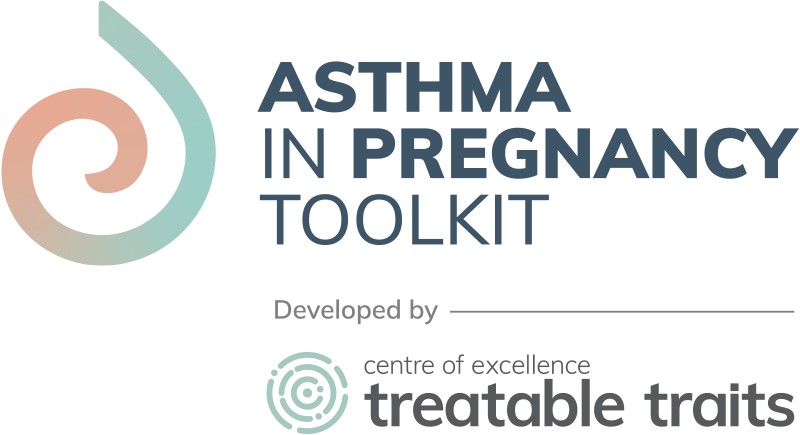Prior to Labour and Birth
- Advise women with asthma to alert their midwife or obstetrician that they have asthma and that this is recorded in their birth plan.
- In women with severe asthma, a management plan may be required prior to labour and birth to establish the place and type of birth, monitoring requirements for mother (e.g. oxygen) or baby during labour and the provision of required asthma inhalers or other asthma medications (Middleton et al. 2020).
During Labour
- Exacerbations of asthma are uncommon during labour and birth (Jana et al. 1995, Stenius-Aarniala et al. 1988, Schatz et al. 2003), consistent with studies showing that asthma is more likely to improve in the third trimester (Schatz et al. 1988).
- Symptoms of asthma during labour are generally controlled with standard asthma therapy (McDonald & Burdon 1996).
- Bronchoconstriction may be caused by hyperventilation during labour and should be managed with inhaled short acting beta agonists (GINA 2021).
- Symptoms of asthma during labour are more likely to occur in women with severe asthma (Schatz et al. 2003).
- Inhaled β-agonists do not impair uterine contractions or delay the onset of labour (McDonald & Burdon 1996).
- Continue preventer medication during labour as per usual individual regimen (McDonald & Burdon 1996, BTS/SIGN 2019, National Asthma Council 2022, GINA 2021).
- Women receiving steroid tablets at a dose exceeding prednisolone 7.5 mg per day for more than two weeks prior to birth should receive parenteral hydrocortisone 100 mg 6–8 hourly during labour (BTS/SIGN 2019).
- Except in the most severe cases, asthma should not preclude a vaginal birth. Children whose mothers have asthma are already at increased risk of developing asthma, and being born by caesarean section may also increase the risk of wheeze and asthma in the offspring (Lin et al. 2021, Kahr et al. 2015).
- Occasionally, women with very severe asthma may be advised to have an induction of labour or a caesarean section (CS) at a time when their asthma is well controlled (McDonald & Burdon 1996). Women with asthma may also be induced for other obstetric reasons, as for women without asthma.
- If induction of labour or CS is required, plan induction after 37+6 weeks unless there are medical complications requiring earlier intervention (National Asthma Council 2022).
- In the absence of an acute severe asthma attack, reserve CS for the usual obstetric indications (Middleton et al. 2020).
Induction of Labour
- Prostaglandin E2 (Cervidil®) (Schatz & Dombrowski 2009) and oxytocin (McDonald & Burdon 1996) may be used to induce labour for women who have asthma, as there is no evidence that these agents cause changes in lung function or increase exacerbation risk (Rooney Thompson et al. 2015).
- However, use of prostaglandin F2α should only occur with extreme caution in women with asthma because of the risk of inducing bronchoconstriction (BTS/SIGN 2019).
Anaesthesia
- If anaesthesia is required, regional anaesthesia is preferred over general anaesthesia for virtually all CS as this reduces airway irritation and potential postoperative complications.
- For women with severe asthma, an anaesthetic consult early in pregnancy is recommended to establish a labour plan including anaesthetic agents to use. A few inhalation agents are known to irritate the airways of patients with severe asthma and induce bronchospasm due to the pungent smell on induction, primarily with desflurane and isoflurane. Other agents like sevoflurane can be used in asthmatic patients to help relax the airways on induction as they do not have such pungent smells (Miller et al. 2021).
- If general anaesthesia is required, a laryngeal mask airway is safer than endotracheal intubation (Burburan 2007).
- Lumbar epidural anaesthesia can be extended if an emergency CS is required (Middleton et al. 2020).
Post-partum
- Hypoglycaemia is a general issue with all preterm babies, but also may occur when high doses of beta-agonists have been given within the last 48 hours prior to delivery. In addition to asthma treatment, beta-agonists are also used for suppression of pre-term labour. If high doses of short acting beta-agonists have been given during labour and birth, blood glucose levels should be monitored in the baby (especially if preterm) for the first 24 hours (GINA 2021).
- A meta-analysis indicated that women with asthma are at increased risk of postpartum haemorrhage (Wang et al. 2014). Prostaglandin F2α is used for treatment of uterine atony and postpartum haemorrhage, but can cause bronchoconstriction (Schatz 1992, Middleton et al. 2020) so should be used with caution in women with asthma.

